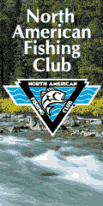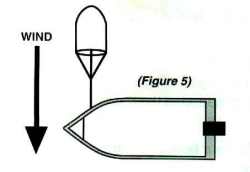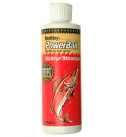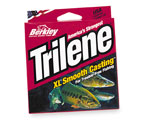
Free 90 day Risk free trial offer click
here













Promotional
Team Favorites
Lodging food and more








|
Early Season River Walleyes
So Sweet So Simple
By Sam Anderson
Shortly after ice-out, male walleyes in the 1
to 3 pound range will move into shallow spawning areas. The best
spawning sites are large sloping shallow bars with a bottom composition
of gravel. The aggressive male walleyes will hold over these areas for
a month or more and feed aggressively during, before and after spawning.
The larger walleyes are most always females, and although they can be taken
during the pre spawn period, they are virtually impossible to take while
spawning and reluctant to bite for a two-week period following the rigors
of procreation.
Although the male walleye is active and aggressive
in early spring, being a cold-blooded creature, his metabolism is determined
by water temperature. This means simply that spring walleyes cannot chase
down a fast moving bait. Slow, slower and slowest are the three speeds
for taking spring walleyes.
The key to locating walleyes in the river in
the late winter and early spring starts with locating a series of obstacles.
Then, allowing your bait or lure to present itself in a natural manner
so the walleye can race from behind the obstruction to acquire the offering
and then race back into the slack water area to digest his meal and await
another.
Look for breaks in the current. They may be behind
islands, points, and below bars in mid channel. In strong current, walleyes
group tight to structure. In softer current or low water periods, like
winter, they often scatter, and hold on edges of barriers or current breaks.
Shallow water is usually defined as any water
that you can't sit on top of with a boat, walleyes can and do inhabit this
type of water. Tradition would say that this is the area that you will
find fish in early spring, summer or fall. But, actually it is where you
will find fish all year round. Some fish could be in 2 feet of water and
others in 20 feet of water on the same body of water at the same time of
year. All in all I have found many walleyes that are aggressive in shallow
water and I'll fish it more times than deep water.
In Minnesota, my home state, the movement of
walleyes toward shallower water is always constant. In early spring the
walleyes are attracted to the aquatic life that is starting in the warm
shallows. As zoo plankton attracts small fish and minnows the walleye is
attracted to these areas to feed. In early spring during the period when
days are warm but nights are cool, baitfish begin breaking the surface
in schools just offshore, particularly during calm periods. This subtle
clue means walleyes are biting like crazy.

Lindy's
Fuzzy Grubs |
Slack water fish can also be found by pitching
Fuzz-E-Grub jigs of 1/16 to 1/8 ounce to shoreline or cover like flooded
wood or boulders |
The angler in this situation should use a lift drop
retrieve to slip or quarter the jig downstream as it is retrieved back
to the boat. This is a super tactic for fishing eddies, wing dams or shallow
mid river shoals. One reason that I like to use jigs while fishing for
spring walleyes in a river system is the control an angler has.
 |
It is true that you have to contend with current
and wind, but using an electric bowmount motor and using a Drift Control
drift sock, I can concentrate on the fishing, because I have control. Vertically
jigging for walleyes gets my blood pumping because I can be on a one to
one bases with the fish. |
My boat is relatively still even in moderate current
with my bowmounted electric motor on about 1/2 speed faced into the current
and a Drift Control drift sock tied off the side of my boat. I can pitch
jigs or crankbaits to any piece of structure. With the proper head design
and weight, jigs are the most versatile of all river techniques, from the
shallowest flooded cover to the deepest, fastest current.
The majority of river fishing with jigs involves
either slipping the current or drift fishing the current breaks. The presentation
is a simple lift-drop-pause method of jigging, raising the jig some 3 to
6 inches as you slip downstream. The jigs that I prefer to use are Lindy
Fuzz-E-Grub jigs because of the rounded head
and the lively marabou tails.

Berkley
Walleye
Scent |
Often times I will sprinkle a little bit of the
liquid Berkley
Walleye Scent on the jig head and the fuzzy
grub body absorbs it and holds it well! The rounded head allows the
jig to bump along the bottom and not get hung up in snags or brush.
If you are as vertical as possible the jig will stand up allowing the hook
to be exposed away from the floor of the river. When you tip the
jig with a fathead minnow the minnow stands up and looks like it is trying
to pick up the jig. |
As the minnow struggles against the weight of the
jig it sends off wounded signals and the natural scent attracts the walleyes
and allows them to hang on just that much longer. If the walleyes seem
to be just biting the tails off the minnows then attach a stinger hook.
The stinger hook is a great addition in the cold waters of spring and summer.

Berkley
Trilene
XL |
Equipment becomes essential when fishing in the
spring, especially line. I like to use the Berkley
Trilene XL blue colored line. The reason for
the is this that blue color is also completely invisible in both muddy
and clear water making it difficult for the fish to detect. |
This makes line watching easy out of the water, any
simple movement can be detected by the eye. The critical aspect is the
fish can't see the line at all and all of a sudden a bait appears before
them.
One device I like to use is the "Thill Float".
Unlike the more familiar and traditional bobber that snaps in place and
is held stationary on the line, the Thill Float has a hollowed out tip
for ease of line attachment. The stopper is a rubber snubber, rubber band,
pretied knot, or a spring device that is placed on the line at the desired
depth. The stopper can be reeled onto the spool and does not interfere
with casting or retrieving. A split shot a foot above a small hook completes
the outfit. Changing depths is a simple matter of sliding the float stop
up or down the desired distance. Probably the most effective and useful
slip bobber that I use is the Thill Float. These floats are pencil designed,
for using in shallow, windy, or over the top of a gravel bar you can't
beat them for performance.
I like to attach a 1/16 or 1/32 ounce Fuzz-E-Grub
jig to the end of the line instead of a plain hook. I like the color that
a jig head adds plus I need to add a little extra weight to pull the line
down to the preset depth when using a jig head. If you use this slip bobber
method, it will enable you to jig your bait vertically without positioning
yourself over the top of the structure. With little or no wind you'll have
action on the bobber. This can easily be achieved by sweeping the rod about
a foot at a time. It might seem simple, and it is, but the results will
astound you.
When the walleye inhales your bait and your bobber
slides slowly underwater, remember to following tips: Take all the slack
out of your line without putting pressure on the fish. When you're ready
to feel the fish reel as quickly as possible putting pressure on the fish.
At the same time "set the hook", lift the rod tip towards the sky and this
will penetrate the bony roof of the walleyes mouth.
With these simple techniques you can also experience
the sweet walleye success on the river. When you really start getting into
them drop me a line at www.samanderson.com
and we can compare notes.

Fish
Clix Banner Exchange
Walleyes Inc. website is maintained
by Randy
Tyler Fishing the In-Fisherman Professional Walleye Circuit, Masters
Walleye Circuit and the Team Walleye Circuit. All rights reserved.Copyright
1999/2002
Please visit these site sponsors
Daiichi/Tru-Turn Hooks,
Lindy
Little Joe,
R-A.M Mounting Systems,
Ranger
boats, Mercury Outboards,
Bedford
Sales , Church Tackle, Panther
Marine Products,
Webfoots body
sock, Bait Rigs Tackle ,Dual
Pro Charging Systems, Daiwa Rods and
Reels, Driftcontrol Wind socks,
Trojan
Batteries
|





